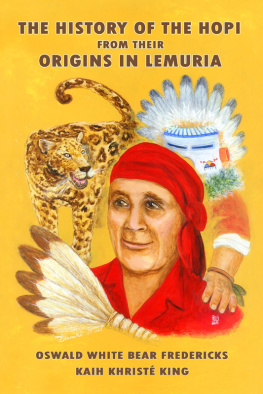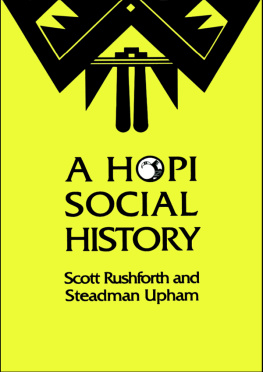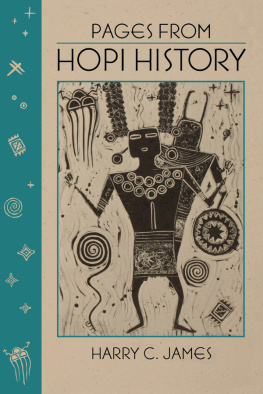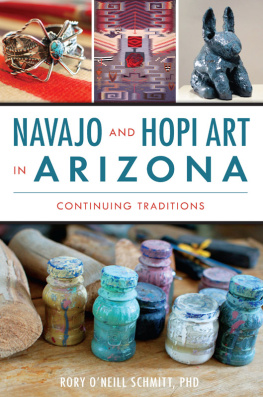Part I
CHAPTER II
MASAUWU
Now the chief was pleased to be on top, but of course, he was rather kind of suspicious for fear that some witches or wizards might have come through. They found that there was sunshine and birds and rather a prosperous looking worldsun, grass, flowers, trees and everything else up above.
When they had been up a few days, the chief asked his people if any of them had brought up anything with them to eat, or seeds of any kind. They searched one another and they found some corn and of course it was rather late in the season to plant anything now, so they didnt plant, they lived on game and wild fruit and seeds of the different kinds of plants.
Before very long there was a little girl who took sick and died suddenly. When this little girl died the chief held a council to find out if they had brought up any witches with them. Finally one of the girls had to admit that she was one of them. Of course they were very much troubled over her and got ahold of her and tied her up and were ready to throw her back into the underworld. The girl didnt want to be thrown back into the underworld so she told them not to be troubled because after death you went back into that underworld and were safe, that you returned to your own people down there again.
They asked her to prove it. Well, she said, I can easily prove it if you come to the kiva (opening). We can look down and see the little dead girl playing around down there just as happy as she can be.
And so they went to the kiva hole and looked down and saw this little girl playing around with the rest of the children below. When the witch girl had proved this to the people the chief had to permit her to stay.
On the fourth night after they came up to the world on top, they saw a fire a little distance away and they wondered who it could be, so the next morning the chief sent his braves to see where the fire had been. No sign of fire was to be found, only huge footprints of a big man or a giant, for these footprints were larger than any living mans. The braves came back to the chief and told of what big footprints they had seen, and they were all very much frightened. The chief thought the only thing to do was to have a ceremony of prayer offerings or paho making and offer these to their neighbor, the giant, for fear that he might be a man of some power, who might do them harm someday.
The village crier was called to announce the day for this ceremony. When the people came to the chief they found him to be sad of heart and they all knew why he was so sad. The chief told his fellow men what he thought it was best they should do, that they might make these prayer offerings to the fire or whoever it was that had the fire. As usual they all smoked their pipes before they set to work to make their pahos. When all was done they put these offerings together on one plaque, which received their earnest prayers as they smoked their pipes, and all this was done before it was taken to their strange neighbors.
Before it was taken over, the chief called for volunteers, to see who would step forward to take these prayer offerings to the being at the fire. They were to be taken at night and someone would have to carry it who was very brave. Four young men offered themselves and said they would take the offering over to the fire for among the Hopi four was the limit, and they were permitted to go.
Going over with the tray of prayer offerings they saw at first in the distance only a faint light and they were very much afraid. Coming closer, they could see someone sitting by the fire and facing away from them and they could only see the back of his head. This head was of rather a great size, like the biggest squash, and there was no hair on it. As they came closer they were more and more frightened, but at last they got to him. He would not turn his face toward the fire, so they called to him and asked him who he was, but he would not answer. They called to him a second time and he ref used again to answer them. They called to him a third time, and again they received no answer. They called again, a fourth time, and asked him if he had some other language and did not understand them. Then he answered and said he was surprised to see that they had come to his fire because no one had ever gotten so near to him before.
When he said this he turned around toward the light and his face was all bloody and he had a mask on; his head was big and his mask was terrible looking. These four men were very much frightened and all felt something creeping back of their heads. Finally they got over their spell and told him what they had brought him, which the chief had sent over with his wishes that he would be their good friend and neighbor and not try to make them any trouble. They handed him the tray of pahos which he gladly received and was very much pleased with them, and he said that he prized them very highly.
Then he told these young men who he was. He was their godthe god of the Upper World, and it all belonged to him. Although being the god of the Upper World, he could not walk about in the day time, but only at night by the light of the fire. So he told these young men to tell their chief who he wasthat he was now his god, who walked in the dark and is called the Masauwu. He was the god of death and life. He told the young men to tell the chief not to be afraid, that he being the god of death, whoever died would go to him first and he would show him back to the underworld by way of the kiva, through which they had come out.
When the young men went back to the chief, they told him the man at the fire received his offering and prized it very highly as it had been a long time since he had received any offering of pahos like that. This was the first time they had ever seen this man who said he was their god and ever since he has been worshipped by the Hopi. Since he told the people he was the god of death, they always go to him when they go on the warpath and ask him to paralyze their enemies with fear so that they may be victorious.
CHAPTER III
HOW THE MOCKING BIRD GAVE THE PEOPLE MANY LANGUAGES
AFTER awhile the chief said that they must move away from the kiva for fear that some of his people might become discouraged in some way, or lose courage and want to go back. They might die or want to die, so he didnt like to be near the kiva for fear the people might be going back and looking down toward their old home.
Even though the Chief had decided to move the people away from the kiva he was very much troubled and wondered how the kiva should be regarded by them, whether it should be thought of with apprehension and fear. So the chief called his wise men together to consult them on his ideas regarding this matter, but none of these men could give him any help or find him an answer. They could only ask him what he had in mind, saying that whatever the chief wished, their gods may consent to fulfill. Very well, said their chief, let us make some pahos and with these offerings we will ask the big waters to come and cover up the kiva and that will make it impossible for anyone to go back there.
When all these were made the young men were asked to take them to the southwest, toward Patuwakachi (the ocean) and at a good distance away from the kiva these pahos were set with the wishes and prayers of the chief that the waters may only come as far as the spot where the offerings were placed. Now every day, for four days the young men were sent back to this place where they had put these pahos to see if there were any signs of moisture or the coming of Paso (the roaring waters). Now every day the water was seen to be creeping up on these pahos and at the end of the fourth day the people began to feel the damp air. Then the big wind came and it kept up for many days and at last







